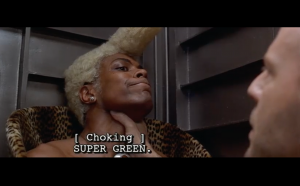Structural Analysis
Pas de Deux
Chandler Pearson, Desmond Butler, Sarah Hollinger, Ben Gips
Part 1: Plot
Sequence 1 – Prologue In the prologue, instrumental music plays. The phrase “we live between two worlds / the digital and the real” appears on screen, followed by Pas de Deux.
Sequence 2 – Waking Up Wide establishing shots introduce the setting of Horn Hall. Within a bedroom, a wide shot shows Chandler sleeping. Her iPhone alarm rings, and a quick close-up shows it greeting her good morning. In a medium shot, Chandler grabs her phone and scrolls through Twitter. The images she sees are reflected in the wall, including several racialized memes and videos. As the camera zooms into Chandler’s eye, we see the image reflected within it.
Sequence 3 – Getting Ready Exiting her room, Chandler walks toward the camera and turns right into the bathroom. Inside, we see through an over the shoulder shot that she is preparing to post a photo to Instagram. The music crescendos. As she posts, a wide shot reveals another image of Chandler appear on the other side of the mirror, our first glimpse of alter-ego Chandy. Chandy is dressed in a polished outfit with Instagram “like” notifications popping up all around her. She touches up her hair as Chandler brushes her teeth in her pajamas.
Sequence 4 – Walking to Class We see split screen wide shots of Chandler and Chandy walking to class. Chandler keeps her head down as she passes Desmond. Chandy waves enthusiastically as Digital Desmond strolls by in a hoodie and backpackless. In a single screen wide shot, Chandler walks towards Ben. As the two pass, Chandy appears in Chandler’s place and Digital Ben’s walks on backpackless, though wearing the same clothes.
Sequence 5 – The Classroom Chander arrives to class where Sarah waits. The two greet each other, and as Chandler takes out her phone, Chandy reappears next to her, now appearing significantly larger than Chandler. Chandler and Sarah discuss a friend’s Instagram post, which Chandler calls “so extra” just as an over the shoulder shot shows her liking it on her phone.
Sequence 6 – The Gym A long shot shows Chandler walking into the gym toward the treadmills. As she starts her run, Chandy appears on the treadmill next door walking slowly and flexing for the mirror. A brief close-up of Chandler’s treadmill shows her slowing down. Chandy immediately chides her for stopping, reminding her that spring break is around the corner. Chandler reluctantly turns her speed back up.
Sequence 7 – Bedtime In a split screen shot, Chandler sits in bed scrolling on her phone. We see her phone screen appear on Chandy’s abdomen. As Chandler goes to delete the Instagram app, Chandy looks purposefully at her and says “but what would you be without me.” Chandler deletes the app, and both sides go dark. After a moment, Chandy’s side illuminates again. An extreme close up shows her expressionless face.
Sequence 8 – Epilogue The text from the prologue reappears. This time, after it is completed, the words “and the real” disappear letter by letter.
Words: 493
Part 2: Analysis

Pas de Deux, a french phrase meaning a dance for two, is a cautionary tale about the construction of the self in two converging worlds: ‘the digital’ and ‘the real’. In the medium shot above, Chandler’s digital self has just appeared. Unbeknownst to Chandler, her instagram post brought her digital self into sentience. The mirror imagery aims to highlight the digital self as a reflection of the real, though something existing in an entirely different dimension. Up until this point, we’ve seen Chandler use her phone a great deal to begin her day. This is something intended to relate to the audience – starting the morning with a scroll to catch up on the latest news. Just as the audience begins to associate themselves with Chandler, this alter ego appears in a surprising turn of events. As it becomes clear that this alter ego is in fact Chandler’s digital self, the moment aims to push the audience toward considering whether they might have a similar moment of reckoning with their own digital self. This makes the audience pose the piece’s central question to themselves, even before our answer begins to reveal itself.
Throughout the rest of the short, her digital self begins to challenge their power dynamic in Chandler’s real world. The physical differences between Chandler and her digital self point to the curated, aesthetically conscious nature of the digital realm. In the real world, Chandler goes about her day rarely smiling, wearing muted colors, and passively consuming digital content on her phone. In contrast, Chandler’s digital self is animated, vain, and presented as a caricature of Chandler. The visual representation of the dual-self in this short invites the audience to consider how our digital identities control our behaviors in real life.
The extent to which the real self has control over the online self is predicated on representations of race in the digital world. For example, as Chandler walks to class she passes a fellow student, Desmond, who is also accompanied by his digital self. In real life, he is wearing his collegiate team gear. However, his digital self is wearing a nondescript jacket with his hood up shielding his identity. Although he is a digital representation, there is no evidence on screen that the self in the hoodie is the same person as the student walking by Chandler in the real life. The visual of a hooded black man here represents the flattening of black identities into a singular, problematic trope. Specifically, this is the trope of the hooded black man as dangerous and threatening to civil life. Regardless of the real intricacies to this student’s identity and how he decides present himself the world, he has less control over how he is perceived. In large part, digital medias reify this dynamic by circulating content that reflects the real worlds biases.
Words: 472


